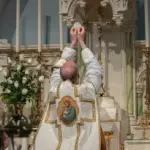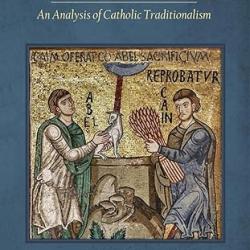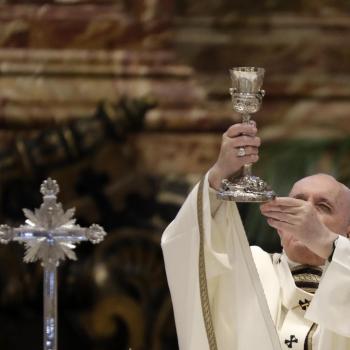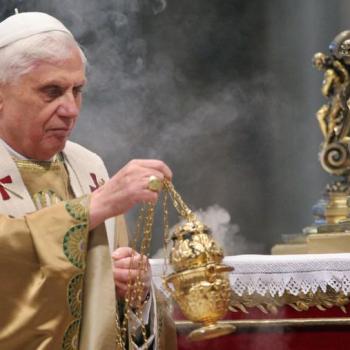
The Essential Guide to Ratzinger is an accessible and yet thorough synthesis of the theological mind and spiritual witness of Joseph Ratzinger—later Pope Benedict XVI.
Perhaps Ramage’s greatest achievement is his success in liberating Ratzinger from the clutches of partisan misuse, presenting him instead as he truly was: a faithful disciple of Christ, a devoted man of the Church, and one of the most profound theological minds of our contemporary age.
At the heart of Ramage’s study is what he identifies as Ratzinger’s most significant contribution to biblical interpretation: “Method C”, introduced in his 1988 Erasmus Lecture. This interpretive method offers a creative and faithful synthesis of the patristic-medieval approach to Scripture (Method A)—which emphasizes divine inspiration, truth, and the transformative power of the Word—and the historical-critical method (Method B ), which draws on the advances of modern scholarship and scientific rigor. Ratzinger’s Method C seeks to harness the strengths of both while remaining honest about their respective limitations.
In doing so, Ratzinger draws an essential distinction between a “scientific hermeneutic” and a “faith hermeneutic.” The former asks what the human authors of Scripture intended to communicate in their own time and place; the latter asks what God is saying through that text today. This balance between critical rigor and spiritual receptivity brings to life the fourfold sense of Scripture and calls interpreters to read every passage in light of the whole of Scripture and the living tradition of the Church. Ramage captures this beautifully, showing how Ratzinger’s exegetical approach makes room for both scholarship and lectio divina, academic study and contemplative prayer.
From the Word of God, Ramage naturally transitions into Ratzinger’s broader theological vision—particularly his reflections on doctrinal development and reform. Drawing from his Light of the World and other key texts, Ramage shows how Ratzinger applies John Henry Newman’s famous dictum: “To live is to change, and to be perfect is to have changed often.” Ratzinger understood that not all change is created equal. For Ratzinger, authentic reform always involves a return to the Gospel, not a departure from it. Ramage explains that Ratzinger invites us to ask three fundamental questions: First, what is an essential component of our Faith? Second, what legitimately changes with the times? and Third, what is non-essential. These questions are central to discerning the difference between perennial truths and historically conditioned expressions of the faith. Ratzinger thus echoes Pope John XXIII, who at the opening of Vatican II, the great reforming council of our age, made this principle clear when he stated how “the Deposit of Faith is one thing, the way it is expressed is another.” Later, Pope Benedict XVI would cite this speech of Pope John’s in his 2005 Christmas Address to the Roman Curia, developing his famous “hermeneutic of Reform in Continuity”.
Yet Ratzinger is equally clear that the Church is not a free-for-all in which individuals make such discernments alone. The only competent authority in these matters is the magisterium of the Church, headed by the pope. In faithfully submitting to this teaching authority—even as a theologian of great stature, from his earliest days—Ratzinger models joyful obedience and ecclesial humility, which cultivated in him the right disposition necessary for when he would eventually embrace the papal office. As Ramage notes, this balance between reverence for tradition and openness to development and renewal, defines Ratzinger’s theological legacy.
This vision is particularly evident in Ratzinger’s treatment of religious freedom, one of the most misunderstood developments of Vatican II. Ramage carefully walks readers through Ratzinger’s explanation of how Vatican II’s teaching on religious liberty, Dignitatis Humanae, did not reverse earlier teaching—such as that found in Pius IX’s Syllabus of Errors—but clarified it. The shift, Ratzinger explains, was from a model rooted in outdated political assumptions to one grounded in the Church’s deeper theological anthropology, which sought to stress that a true religious act requires that it not be compelled by force. This change in expression did not compromise the faith, but deepened its understanding.
From here, Ramage delves into Ratzinger’s approach to biblical scholarship and the Church’s evolving acceptance of historical-critical insights. He explores how earlier magisterial restrictions—such as prohibitions on believing the Pentateuch had multiple authors, or affirming Mark’s priority as the first Gospel—were later overturned with the support of both Benedict and John Paul II. Ramage compares these developments with the Galileo affair, drawing a cautionary parallel about the dangers of conflating disciplinary prohibitions with doctrinal finality. Ratzinger always stressed that faith and reason, when rightly understood, cannot truly conflict.
This harmony between faith and reason is a dominant theme throughout Ratzinger’s theology, especially in his approach to creation. As co-director of Benedictine College’s Center for Integral Ecology, Ramage devotes appropriate attention to Ratzinger’s insights on the book of Genesis. Ratzinger rejected the belief that a literalist reading of the seven-day creation narrative was necessary or even advisable, emphasizing instead its theological and covenantal message. Scripture, he insisted, is not a scientific textbook but a divine pedagogy. The account of Adam and Eve, too, is best understood not as a biological origin story but as an archetypal reflection of humanity’s fall and vocation. This more nuanced reading provides a foundation for Ratzinger’s vision of care for creation and respect for man’s dignity, rooted in the theological realization that creation is gift borne out of God’s love for us.
Closely linked to his theology of creation is Ratzinger’s view that faith must be lived to be truly understood. Ramage brings out the existential dimension of Benedict’s thought: the “experiment” of faith, tested and deepened through acts of love, contemplation, and humility. Ramage notes how Ratzinger teaches in Lumen Fidei, that love itself is a mode of knowledge, and that real understanding comes not only from the intellect but through charity. Nonetheless, Ramage notes Ratzinger’s recognition of his own limitations, and how he does not shy away from treating the difficulties of belief in a secular age. Drawing from Ratzinger’s Last Testament, Ramage offers a moving account of the Pope Emeritus’ own struggles which remind us that when faced with mystery or doubt in the face of a scripture passage or Church teaching one doesn’t understand, “You must be humble. You must wait until the Lord opens it for you.”
Ramage also explores Ratzinger’s engagement with modern critics of religion, particularly Nietzsche and Rousseau. Nietzsche charges that faith is for the weak; Rousseau objects to the Church mediating between man and God. Ratzinger responds that a “do-it-yourself” faith is not courageous—it’s convenient. What requires true courage is obedience to the truth, especially when it contradicts the spirit of the age. Obedience to the Church, he insists, saves us from the narcissism of a self-made religion.
Perhaps Ramage’s greatest achievement is his success in liberating Ratzinger from the clutches of partisan misuse, presenting him instead as he truly was: a faithful disciple of Christ, a devoted man of the Church, and one of the most profound theological minds of our contemporary age.
At the heart of Ramage’s study is what he identifies as Ratzinger’s most significant contribution to biblical interpretation: “Method C”, introduced in his 1988 Erasmus Lecture. This interpretive method offers a creative and faithful synthesis of the patristic-medieval approach to Scripture (Method A)—which emphasizes divine inspiration, truth, and the transformative power of the Word—and the historical-critical method (Method B ), which draws on the advances of modern scholarship and scientific rigor. Ratzinger’s Method C seeks to harness the strengths of both while remaining honest about their respective limitations.
In doing so, Ratzinger draws an essential distinction between a “scientific hermeneutic” and a “faith hermeneutic.” The former asks what the human authors of Scripture intended to communicate in their own time and place; the latter asks what God is saying through that text today. This balance between critical rigor and spiritual receptivity brings to life the fourfold sense of Scripture and calls interpreters to read every passage in light of the whole of Scripture and the living tradition of the Church. Ramage captures this beautifully, showing how Ratzinger’s exegetical approach makes room for both scholarship and lectio divina, academic study and contemplative prayer.
From the Word of God, Ramage naturally transitions into Ratzinger’s broader theological vision—particularly his reflections on doctrinal development and reform. Drawing from his Light of the World and other key texts, Ramage shows how Ratzinger applies John Henry Newman’s famous dictum: “To live is to change, and to be perfect is to have changed often.” Ratzinger understood that not all change is created equal. For Ratzinger, authentic reform always involves a return to the Gospel, not a departure from it. Ramage explains that Ratzinger invites us to ask three fundamental questions: First, what is an essential component of our Faith? Second, what legitimately changes with the times? and Third, what is non-essential. These questions are central to discerning the difference between perennial truths and historically conditioned expressions of the faith. Ratzinger thus echoes Pope John XXIII, who at the opening of Vatican II, the great reforming council of our age, made this principle clear when he stated how “the Deposit of Faith is one thing, the way it is expressed is another.” Later, Pope Benedict XVI would cite this speech of Pope John’s in his 2005 Christmas Address to the Roman Curia, developing his famous “hermeneutic of Reform in Continuity”.
Yet Ratzinger is equally clear that the Church is not a free-for-all in which individuals make such discernments alone. The only competent authority in these matters is the magisterium of the Church, headed by the pope. In faithfully submitting to this teaching authority—even as a theologian of great stature, from his earliest days—Ratzinger models joyful obedience and ecclesial humility, which cultivated in him the right disposition necessary for when he would eventually embrace the papal office. As Ramage notes, this balance between reverence for tradition and openness to development and renewal, defines Ratzinger’s theological legacy.
This vision is particularly evident in Ratzinger’s treatment of religious freedom, one of the most misunderstood developments of Vatican II. Ramage carefully walks readers through Ratzinger’s explanation of how Vatican II’s teaching on religious liberty, Dignitatis Humanae, did not reverse earlier teaching—such as that found in Pius IX’s Syllabus of Errors—but clarified it. The shift, Ratzinger explains, was from a model rooted in outdated political assumptions to one grounded in the Church’s deeper theological anthropology, which sought to stress that a true religious act requires that it not be compelled by force. This change in expression did not compromise the faith, but deepened its understanding.
From here, Ramage delves into Ratzinger’s approach to biblical scholarship and the Church’s evolving acceptance of historical-critical insights. He explores how earlier magisterial restrictions—such as prohibitions on believing the Pentateuch had multiple authors, or affirming Mark’s priority as the first Gospel—were later overturned with the support of both Benedict and John Paul II. Ramage compares these developments with the Galileo affair, drawing a cautionary parallel about the dangers of conflating disciplinary prohibitions with doctrinal finality. Ratzinger always stressed that faith and reason, when rightly understood, cannot truly conflict.
This harmony between faith and reason is a dominant theme throughout Ratzinger’s theology, especially in his approach to creation. As co-director of Benedictine College’s Center for Integral Ecology, Ramage devotes appropriate attention to Ratzinger’s insights on the book of Genesis. Ratzinger rejected the belief that a literalist reading of the seven-day creation narrative was necessary or even advisable, emphasizing instead its theological and covenantal message. Scripture, he insisted, is not a scientific textbook but a divine pedagogy. The account of Adam and Eve, too, is best understood not as a biological origin story but as an archetypal reflection of humanity’s fall and vocation. This more nuanced reading provides a foundation for Ratzinger’s vision of care for creation and respect for man’s dignity, rooted in the theological realization that creation is gift borne out of God’s love for us.
Closely linked to his theology of creation is Ratzinger’s view that faith must be lived to be truly understood. Ramage brings out the existential dimension of Benedict’s thought: the “experiment” of faith, tested and deepened through acts of love, contemplation, and humility. Ramage notes how Ratzinger teaches in Lumen Fidei, that love itself is a mode of knowledge, and that real understanding comes not only from the intellect but through charity. Nonetheless, Ramage notes Ratzinger’s recognition of his own limitations, and how he does not shy away from treating the difficulties of belief in a secular age. Drawing from Ratzinger’s Last Testament, Ramage offers a moving account of the Pope Emeritus’ own struggles which remind us that when faced with mystery or doubt in the face of a scripture passage or Church teaching one doesn’t understand, “You must be humble. You must wait until the Lord opens it for you.”
Ramage also explores Ratzinger’s engagement with modern critics of religion, particularly Nietzsche and Rousseau. Nietzsche charges that faith is for the weak; Rousseau objects to the Church mediating between man and God. Ratzinger responds that a “do-it-yourself” faith is not courageous—it’s convenient. What requires true courage is obedience to the truth, especially when it contradicts the spirit of the age. Obedience to the Church, he insists, saves us from the narcissism of a self-made religion.
This theme of obedience naturally leads into Ramage’s treatment of Ratzinger’s liturgical theology, where the pope’s priorities are frequently misunderstood. Though he personally preferred ad orientem celebration and had a deep love for the Traditional Latin Mass, Ratzinger never sought to overturn the liturgical reforms of Vatican II. He respected the Council’s decisions and urged that the faithful understand how there is continuity between the two forms rather than rupture. The pope believed that rupture presents itself, rather, through deviation from the Church’s rubrics, through “do-it-yourself liturgy”. The pope’s decision to allow broader access to the older form of the Roman Rite was not a rejection of the new, but an invitation to unity—an invitation tragically hijacked by some who used it to advance anti-conciliar agendas. These agendas Pope Francis later acted to curb through his restriction of the preconciliar form of the rite, in Traditionis Custodes, though while still affirming Benedict’s essential insight: the true renewal of the liturgy lies in celebrating the Mass well, by fostering the ars celebrandi, or the art of celebrating the mass with reverence and fidelity, according to the rubrics of Holy Mother Church.
Ramage then continues his exploration of Ratzinger’s theology with a chapter on Ratzinger’s eschatology, focusing especially on Spe Salvi and his meditations on Holy Saturday. Ramage concludes the book by also touching on many other essential themes of Ratzinger’s corpus: his Trinitarian theology, his reflections on the imago Dei and its implications for human dignity, his unwavering emphasis on prayer and the universal call to holiness, and his vision for faith in public life. In every chapter, Ramage resists the temptation to use Ratzinger for factional purposes. Instead, he invites readers to encounter the full breadth of a man whose thought was as rooted in tradition as it was open to the future.
In short, The Essential Guide to Ratzinger is exactly what it claims to be: a guide—not only to the man or his writings, but to his message. Ratzinger’s message, grounded in Christ and carried by the Church, remains as dynamic as ever. For students of theology, catechists, pastors, and all who seek to understand the legacy of Benedict XVI, this book is, as the title suggests, a critical resource and companion to the thought of one of the greatest minds of the last century.
Ramage then continues his exploration of Ratzinger’s theology with a chapter on Ratzinger’s eschatology, focusing especially on Spe Salvi and his meditations on Holy Saturday. Ramage concludes the book by also touching on many other essential themes of Ratzinger’s corpus: his Trinitarian theology, his reflections on the imago Dei and its implications for human dignity, his unwavering emphasis on prayer and the universal call to holiness, and his vision for faith in public life. In every chapter, Ramage resists the temptation to use Ratzinger for factional purposes. Instead, he invites readers to encounter the full breadth of a man whose thought was as rooted in tradition as it was open to the future.
In short, The Essential Guide to Ratzinger is exactly what it claims to be: a guide—not only to the man or his writings, but to his message. Ratzinger’s message, grounded in Christ and carried by the Church, remains as dynamic as ever. For students of theology, catechists, pastors, and all who seek to understand the legacy of Benedict XVI, this book is, as the title suggests, a critical resource and companion to the thought of one of the greatest minds of the last century.
















